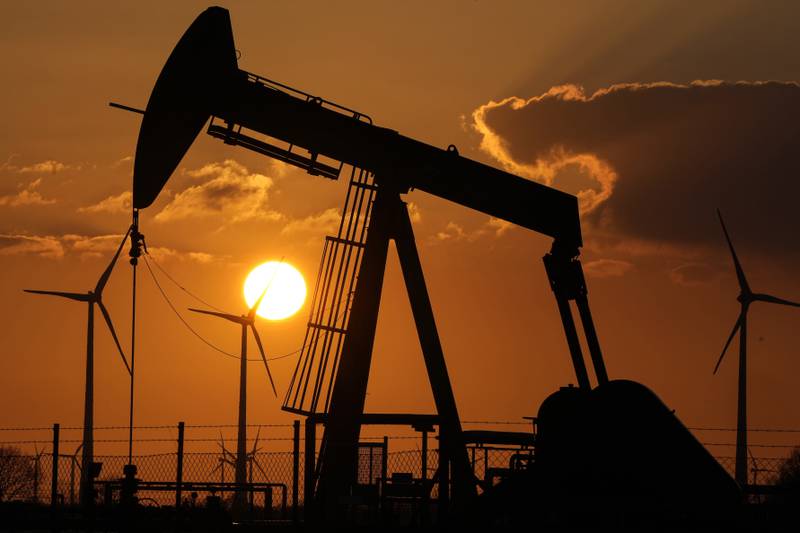Oil prices drop as demand concerns dominate supply issues amid geopolitical conflict
31 August, 2022

Oil prices fell on Tuesday as demand concerns dominated supply constraints that have persisted amid Russia’s military offensive in Ukraine and the continuing conflict in Opec member Libya.
Brent, the benchmark for two thirds of the world's oil, was trading 4.36 per cent lower at $100.48 a barrel at 6.36pm UAE time. West Texas Intermediate, the gauge that tracks US crude, was down 4.22 per cent at $92.92 a barrel.
“Physical and futures markets have been moving in more or less synchronised patterns, although the absolute level and swings in time spreads are considerable,” Edward Bell, senior director of market economics at Emirates NBD, said.
“The downward move in oil and commodity prices over the Northern Hemisphere summer months has been largely down to adjustments in demand expectations.”
Investors are increasingly worried that a looming recession could affect fuel demand, even as central bank governors continue to tighten monetary policy to tame higher inflation globally. US Federal Reserve chairman Jerome Powell said on Friday that the US economy would need a tight monetary policy “for some time” to beat record-high inflation and that American households and businesses would feel “some pain”.
The US central bank already raised interest rates by 75 basis points in its past two meetings and is expected to do so again when it meets from September 20 to September 21.
“Oil has been trending lower but the supply side risks are too great and prices need to find a home above the $100 a barrel level,” said Edward Moya, a senior market analyst for the Americas region at Oanda.
“The one trade that everyone can agree upon is that the oil market will likely remain tight.”
Fears of supply tightening have been aggravated as Russia this week intensified its military offensive in Ukraine and clashes erupted in Libya between supporters of two rival governments that operate from two different cities in the North African country.
At least 32 people were killed and 159 wounded in the latest fighting in the capital, Tripoli, on Saturday, according to Libya’s health ministry.
Libya, which has some of the cheapest oil in Northern Africa, had much of its production disrupted during the civil war that erupted after the downfall of the country's former leader, Muammar Qaddafi, in 2011.
Meanwhile, Opec's second-largest producer, Iraq, has also been hit by political upheaval this week after cleric Moqtada Al Sadr announced he was quitting political life. However, oil installations in the country, which exports about 3.3 million barrels of crude a day, have not been been affected so far and oil production has continued uninterrupted.
“Brent and crude oil prices had some tough times, but this week, the game has changed once again as crude and Brent oil prices recorded serious gains yesterday,” said Naeem Aslam, chief market analyst at Avatrade.
Oil prices rose on Monday amid the possibility that Saudi Arabia and its allies at Opec+ could cut output to counter market volatility, as well as fears of supply disruptions in Libya.
“The reason that we are seeing oil prices moving higher once again is the geopolitical tension,” Mr Aslam said.
“The Russian invasion of Ukraine is still ongoing and, in the past few days, the situation has become more intense. In addition to this, traders are also factoring in a production cut by Opec+.”
Saudi Energy Minister Prince Abdulaziz bin Salman said in an interview with Bloomberg last week that Opec and its allies would cut production if required to counter the volatility in oil prices.
Opec+ has “the commitment … and the means” to deal with volatility in prices and “provide guidance, including cutting production at any time and in different forms”, Prince Abdulaziz said.
The supergroup of 23 producers, led by Saudi Arabia and Russia, agreed earlier this month to raise production by 100,000 barrels per day in September amid pressure from major consumers, including the US, to cool prices.
The group will meet on September 5 to decide on its future output policy.
“Supply issues are driving the market at the moment, with markets likely expecting some kind of downward adjustment to Saudi supply when Opec+ meets next week,” said Khatija Haque, head of research and chief economist at Emirates NBD.
Opec+ may look to cut production at upcoming meetings to counter any further downside in oil, added Mr Bell.
The group consisting of top producers “may not need to actually approve a cut in production at next week’s meeting but rather just rollback the planned production increase for September or keep target levels unchanged for October onward", he said.
As oil markets move into the fourth quarter, the effect of sanctions on Russia’s oil production will start to be felt much more, he said.
The EU's sanctions on imports of seaborne Russian crude oil take effect from the start of December while sanctions on product imports will take hold in the first quarter of 2023.
“The current oil futures curve implies a general move lower in prices over 2023. But given the tight supply picture over the coming quarters, oil markets may need to prepare for more considerable upside shocks," Mr Bell said.
China’s ‘zero-Covid’ strategy to stem the Covid-19 pandemic as well as tightening of monetary policy by central banks in the US, UK and the Eurozone to deal with decades-high inflation would be negative for commodities including oil, copper and Iron ore.
Source: www.thenationalnews.com
